Aloo paratha
 Aloo paratha with butter | |
| Alternative names | Aloo ka parantha, aloo prantha, alu porota, aloo de paranthe |
|---|---|
| Region or state | Punjab |
| Main ingredients | Potato, atta, maida, butter or ghee |
| 290-360 kcal (-1217 kJ) | |
Aloo paratha (Urdu: آلو پراٹھا, Hindi: आलू पराठा, Punjabi: ਆਲੂ ਪਰਾਠਾ / آلو پراٹھا, lit. 'potato paratha' ) is a paratha (flat bread dish) stuffed with potato, originating from the Punjab region of South Asia.[1][2] It is traditionally eaten for breakfast.[1][3]
It is made using unleavened dough rolled with a mixture of mashed potato and spices (amchur, garam masala,) which is cooked on a hot tawa with butter or ghee.[4][5] Aloo paratha is usually served with butter, chutney, curd, or Indian pickles.[6] It is also often accompanied with sarson ka saag.[7]
Stuffed with potato and fried makes it of higher calorie (290-360 calories) than a typical roti (60 calories).[5]
In the 21st century, due to convenience, working routines and rising household incomes, smaller families and time restrictions, the aloo paratha breakfast for urban Indians has been increasingly replaced by foods seen as more convenient such as cereals.[3] A similar pattern has been observed among Central Valley Sikhs in America.[1]
See also
References
- ^ a b c Benson, Heather L.; Helzer, Jennifer (January 2017). "Central Valley Culinary Landscapes: Ethnic Foodways of Sikh Transnationals". California Geographer. 56: 55–95.
- ^ Al-Khusaibi, Mohammed; Rahman, Mohammad Shafiur (2019). "1. Traditional foods: overview". In Al-Khusaibi, Mohammed; Al-Habsi, Nasser; Rahman, Mohammad Shafiur (eds.). Traditional Foods: History, Preparation, Processing and Safety. Switzerland: Springer. pp. 1–8. ISBN 978-3-030-24620-4.
- ^ a b Iyer, Lakshmi Shankar (8 June 2014). "A Study of Breakfast Habits of Urban Indian Consumers". The International Journal's Research Journal of Economics and Business Studies. 3 (8): 107–118. ISSN 2251-1555.
- ^ Basak, Somnath; Chakraborty, Snehasis; Singhal, Rekha S. (1 January 2023). "Revisiting Indian traditional foods-A critical review of the engineering properties and process operations". Food Control. 143: 109286. doi:10.1016/j.foodcont.2022.109286. ISSN 0956-7135. S2CID 251334687.
- ^ a b Padave, Chef Priya; Sawant, Chef Vijay; Salvi, Chef Swapnil. Indian Bread: Traditional and Innovative Indian Breads. Educreation Publishing. pp. 25–32. ISBN 978-93-5373-066-6.
- ^ Ananthanarayan, Laxmi; Dubey, Kirti Kumari; Muley, Abhijeet B.; Singhal, Rekha S. (2019). "6. Indian traditional foods: preparation, processing and nutrition". In Al-Khusaibi, Mohammed; Al-Habsi, Nasser; Rahman, Mohammad Shafiur (eds.). Traditional Foods: History, Preparation, Processing and Safety. Switzerland: Springer. p. 135. ISBN 978-3-030-24620-4.
- ^ Sachdev, M; Misra, A (17 January 2022). "Heterogeneity of Dietary practices in India: current status and implications for the prevention and control of type 2 diabetes". European Journal of Clinical Nutrition. doi:10.1038/s41430-021-01067-1. PMID 35039630. S2CID 245988005.





